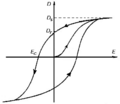Hysteresis facts for kids
Hysteresis is a cool idea in science. It describes how a system's output doesn't just depend on what's happening right now. It also depends on what happened in the past. Think of it like a system having a memory!
This "memory" affects the system's inner state. To guess what a system will do next, you need to know its past. Or you need to know its current internal state.
Sometimes, this effect happens because there's a small lag (delay) between the input and the output. If the input changes very slowly, this delay effect might disappear. This is called rate-dependent hysteresis. It's different from hysteresis where the memory effect lasts longer.
Contents
What is Hysteresis?
Hysteresis means that a system's response depends on its history. Imagine pushing a swing. How high it goes depends on how hard you push it now. But it also depends on how high it was swinging before you pushed it.
Another way to think about it is like a sticky door. If you push it open, it might stay open a bit. When you try to close it, you have to push it past that sticky spot. The door's position depends on whether you were opening it or closing it.
Where Can We See Hysteresis?
Hysteresis shows up in many places. It's not just in science labs!
Magnets and Materials
You can find hysteresis in magnetic materials. Think of a fridge magnet. Once it's magnetized, it stays magnetic even after you remove the magnetizing force. To demagnetize it, you need to apply a force in the opposite direction.
It also happens in materials called ferroelectric materials. These are special materials that can hold an electric charge even after the electric field is removed.
Some materials also show hysteresis when they change shape. A rubber band is a good example. When you stretch it, it takes a certain amount of force. But when you let it go, it doesn't snap back with the exact same force. It might be a little different. Shape-memory alloys are even cooler. They can be bent, but when heated, they return to their original shape!
Everyday Examples
Many things we use every day are designed with hysteresis. This helps them work better.
Thermostats
A thermostat is a great example. Imagine you set your home thermostat to 20°C. If it turned on the heater exactly at 20°C and off at 20°C, it would constantly click on and off. This would waste energy.
Instead, thermostats have hysteresis. They might turn the heater on when the temperature drops to 19°C. Then, they keep it on until the temperature reaches 21°C. This small difference (the "dead band") prevents the heater from cycling too often.
Computers
Even computers use hysteresis! In some parts of computer memory, hysteresis helps keep data stable. It makes sure that a "1" stays a "1" and a "0" stays a "0" reliably.
Images for kids
See also
 In Spanish: Histéresis para niños
In Spanish: Histéresis para niños


